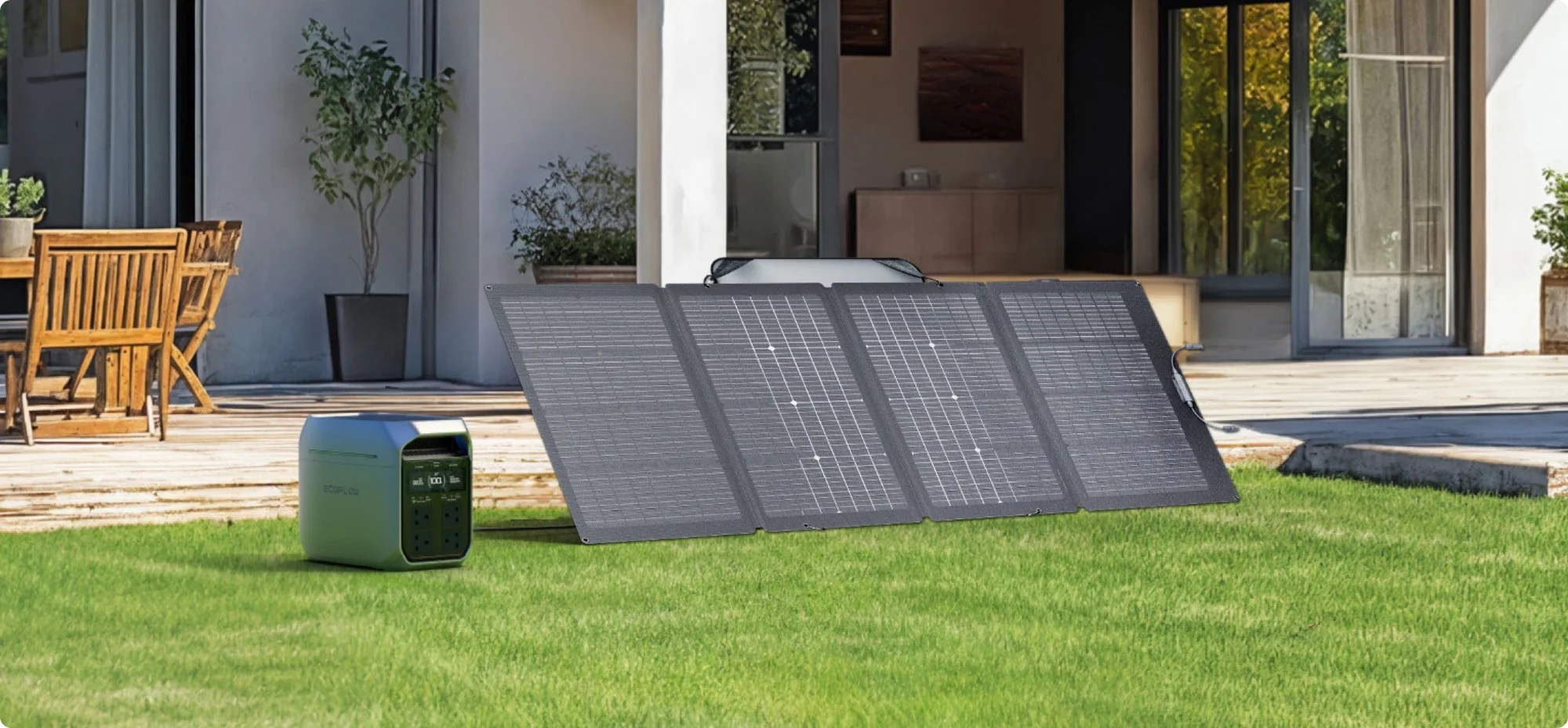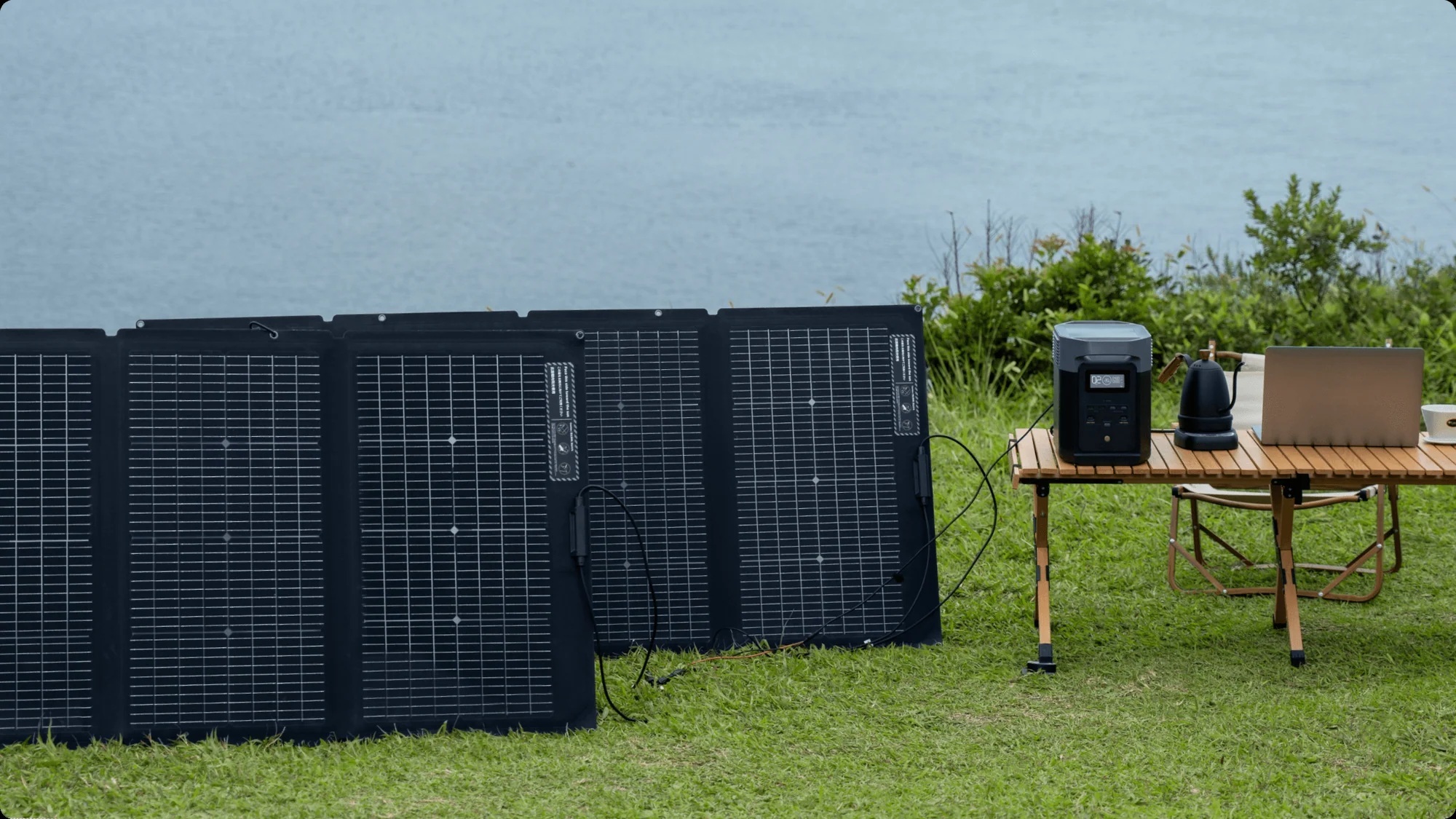Stay Powered: 6 Best Home Emergency Generators of 2025
Power interruptions can disrupt daily life—from essential lighting to refrigerated food and medical equipment. Investing in the best home emergency generator ensures your home stays functional during outages, storms, or grid failures. The following six models have been selected for their reliability, advanced technology, and user-friendly design, making them dependable choices for anyone seeking powerful and efficient backup solutions.
6 Best Home Emergency Generators in 2025
Here are the six top-rated options for 2025, chosen for reliability, ease of use and UK suitability.
EcoFlow DELTA 3 Series Solar Generator (PV220W)
This unit stands out as the best solar generator for emergency home use, outdoor adventures or RV life. With a base capacity of approximately 1,024 Wh (expandable to up to ~5 kWh) and a steady 1,800 W AC output (with boost capability around 2,400 W), it handles most of the gear around the house that matters.
Its solar-charging setup is noteworthy: plug in the included 220 W bifacial panel (plus a 175 W rear surface) and you unlock one of the faster recharge paths available—ideal when sun time is short. Built with LiFePO₄ battery chemistry and rated for 4,000+ cycles until 80% capacity, it’s designed for durability.
Compact (~12.5 kg) enough to sit by the patio or slip into a vehicle, its smart-app monitoring and fast charging (AC + solar) make it a practical, modern power station. Whether it’s lighting up a dark day at home, running key appliances off-grid, or powering essentials on the road, EcoFlow DELTA 3 Series Solar Generator (PV220W) blends reliability with flexibility.

Key specs:
Battery capacity: ~1,024 Wh (expandable up to ~5 kWh)
Continuous AC output: 1,800 W; surge up to ~3,600 W
Weight: ≤ ~12.5 kg (~27.5 lbs)
Fast-charge capability: supports solar input up to ~500 W and multiple charging methods
Battery lifespan: 4,000+ cycles to 80% capacity (LiFePO₄ chemistry)
EcoFlow DELTA 2 Solar Generator (PV220W)
When the power drops out, this unit stands ready without the roar or fumes of a traditional generator. With around 1,024 Wh of stored energy and a smooth 1,800 W inverter output (surging to about 2,700 W), it’s suited to running essentials like fridge, lights, and even a microwave.
Plug in a 220 W bifacial solar panel and you’ve got a fast recharge option: two panels can fill it in roughly 2.9 hours, a perfect match for sunny rooftops or camping days.
Weighing only about 12 kg (27 lbs), it slides easily from garage to patio. Smart features like WiFi/Bluetooth monitoring and a solid five-year warranty make EcoFlow DELTA 2 Solar Generator (PV220W) as much a lifestyle upgrade as a backup.

Key specs:
Battery capacity: ~1,024 Wh (LiFePO₄ chemistry)
AC output: 1,800 W continuous; surge up to ~2,700 W; supports up to ~2,200 W device draw with X-Boost
Solar / input charging: Up to 500 W solar input (11-60 V / 15 A), ~1,200 W AC charging max
Weight: ~12 kg (≈27 lbs)
Cycle life: ~3,000 cycles to 80% capacity
Connectivity: WiFi & Bluetooth monitoring through the EcoFlow app
Hyundai DHY8000SELR Diesel Generator
The DHY8000SELR is designed for home-standby use, offering long-run performance with minimal fuss. The large 25-30 L diesel tank supports up to 30 hours of operation at low load, helping it keep critical devices powered during extended outages.
Powered by a 4-stroke, air-cooled D452 diesel engine running at 3,000 rpm, it delivers a maximum output of around 5.8–6 kW (7.25 kVA) and incorporates an AVR alternator that stabilises voltage for safer use with sensitive equipment.
A silenced canopy keeps noise to about 70 dB at 7 m, making it suitable for residential or light-commercial settings. ATS (Automatic Transfer Switch) compatibility enables automatic startup when mains power fails, streamlining setup and use during emergencies.
Key specs:
Running output: ~5.8 kW / 7.25 kVA standby power.
Engine type: 4-stroke, air-cooled D452 (3000 rpm).
Fuel tank capacity: 25–30 L, enabling up to ~30 hours runtime at light load.
Noise level: Approx. 70 dB at 7 m.
Weight: ~158-167 kg.
Honda EU2200i Companion Portable Generator
The Honda EU2200i Companion steps into the portable generator spotlight by offering more power without sacrificing the trusted reliability Honda is known for. With a maximum output of 2,200 watts (and 1,800 watts rated) it handles appliances like a fridge or a mid-sized saw with confidence.
One of its standout features is the built-in 30-amp outlet, which opens the door for RV hookups or running two units in parallel to double up on power. The compact size—just around 47 lbs—and noise levels of 48–57 dB put it in the “whisper friendly” zone, meaning neighbors or campground companions won’t complain.
Key specs:
Max AC output: ~2,200 watts; Rated AC output: ~1,800 watts at 120 V.
Engine: Honda GXR120 (121 cc)
Noise: 57 dB(A) at rated load; as low as 48 dB(A) at quarter load.
Runtime: Up to ~8.1 hours at ¼ load on a 0.95-gallon tank.
Weight: Approximately 47.4 lbs (dry).
Generac GP9500E TriFuel Portable Generator
This generator brings serious power and serious peace of mind. With 9,500 running watts (and up to 12,500 starting watts on gasoline) it’s ready to keep your home’s essential systems running during an outage.
Flexible fuel options make it easy to get going—switch between gasoline, liquid propane or natural gas with the turn of a dial. A 500 cc OHV engine delivers consistent performance, and onboard COsense® technology actively works to protect against carbon-monoxide hazards.
Outdoors or in the garage, it’s designed to handle tough conditions: a 7.5-gallon fuel tank supports long runtimes (around 9.5 hours at half load on gasoline).
Key specs:
Running wattage: ~9,500 W (gasoline) / ~8,550 W (propane) / ~7,000 W (natural gas)
Starting wattage: ~12,500 W (gasoline) / ~11,250 W (propane) / ~9,000 W (natural gas)
Engine type: 500 cc OHV four-stroke, 3,600 RPM
Fuel types: Gasoline / Liquid Propane (LP) / Natural Gas
Runtime: Up to ~9.5 hours at 50% load on gasoline; ~4.5 hours on LP 20-lb tank at 50% load
Weight: ~219 lbs dry (unit weight)
DuroMax 11,000Watt Portable DualFuel Inverter Generator
Ready to keep your home running when the power goes out, the DuroMax XP11000iH delivers whole-home backup power in a surprisingly portable package. With up to 11,000 watts of surge output (around 9,000 watts continuous on gasoline, around 8,550 watts on propane), it can easily handle essential appliances, lighting, HVAC systems and more.
The clean sine-wave inverter design ensures safe operation of sensitive electronics, while dual-fuel capability (gasoline or propane) gives you flexibility depending on what fuel is readily available. A dedicated 50-amp plug, remote start and quiet operation (about 61 dB at 25% load) round out the features that make this model one of the best generators for home backup power, offering reliable performance when it matters most.
Key specs:
Running wattage: ~9,000 W (gasoline) / ~8,550 W (propane)
Engine type: 459 cc OHV 4-stroke
Fuel types: Gasoline and Propane (dual-fuel)
Weight: ~216 lbs (dry)
Noise level: 61 dB at 25% load
Key Factors to Look for When Choosing Home Emergency Generators
When selecting a backup generator for your home, consider:
Power output: Assess how many and which appliances you’ll want to run simultaneously. Larger homes may need models offering 6 kW or more.
Fuel type and flexibility: Solar-battery stations offer silent operation and no fuel fumes; diesel, gasoline and dual-fuel units provide longer runtime or heavy-load capacity.
Runtime: For battery-based systems check how quickly they recharge, and for fuel generators check tank size and estimated runtime.
Noise & installation: Inverter and battery systems tend to run quietly; fuel-powered models may require sound-reduction enclosures and proper ventilation.
Portability & setup: Consider size, weight and how easily the generator can be moved or installed. Smart-monitoring apps add convenience for battery models.
The Future of Home Backup: Portable Power Stations for Fuel-Free Reliability
While generators remain useful for long, heavy loads, portable power stations have become a viable, fuel-free option for most household backups. They offer silent operation, no on-site emissions, and scalable capacity that meets the needs of typical outages and everyday backup use.
The EcoFlow DELTA Pro 3 Portable Power Station offers quiet, renewable power for everyday use, while a generator provides the extra capacity needed during long outages. It delivers up to 4,000 W continuous (short surges to 6,000W with X-Boost), scales from 4 kWh to 12 kWh, so it handles daily loads and fast daytime top-ups while the generator covers extended demand.
EcoFlow DELTA Pro 3 Portable Power Station
The EcoFlow DELTA Pro 3 Portable Power Station + Smart Extra Battery bundle expands to deliver longer runtimes and higher capacity, forming a dependable home battery storage solution. With 4,000 W continuous output and expandable storage from 4 kWh to 8 kWh, the system can run high-demand appliances like washing machines and EV chargers for extended periods.
EcoFlow DELTA Pro 3 Portable Power Station + Smart Extra Battery
Whether using the EcoFlow DELTA Pro 3 alone or paired with the Smart Extra Battery, these setups let households build a home battery backup system that reduces fuel use, lowers noise, and provides a cleaner way to stay powered through any outage.
Conclusion
A dependable home emergency generator offers peace of mind when utility power fails. The six models listed above provide a range of reliable backup options—from compact solar power stations to high-capacity tri-fuel systems. Choosing the best home emergency generator that matches your household’s energy requirements, installation setup, and preferred fuel type ensures your home stays powered and protected through any outage.
*The brands referenced in this article are provided for informational purposes only and do not indicate any partnership with EcoFlow.
FAQs
What is the best emergency generator for home use?
The best emergency generator for home use depends on how much power you need and how often you experience outages. For most UK households, a solar-ready generator such as the EcoFlow DELTA 3 Series provides clean, quiet power for essentials like lighting, refrigeration, and electronics. If you prefer fuel flexibility, dual-fuel or tri-fuel models such as the DuroMax XP11000iH or Generac GP9500E are excellent options, offering strong output and long runtimes. Diesel standby units like the Hyundai DHY8000SELR are more suited for permanent backup. The best generator for emergency home use is one that balances output, efficiency, and convenience while fitting your home’s energy needs and storage space.
What size generator will run a normal house?
A typical three-bedroom UK house usually requires between 5 kW and 8 kW to keep essentials running. That includes the refrigerator, boiler, lighting, internet router, and small kitchen appliances. If you want to power everything—including electric heating or air conditioning—then a generator rated between 10 kW and 15 kW is more appropriate. Always check both running and surge wattage on your devices, since larger appliances like washing machines or freezers need extra power at startup. It’s best to choose a generator with 15–20% more capacity than your calculated total to avoid overloading and to ensure smoother operation during longer outages.
How big of a generator do I need for a home emergency?
The right size generator depends on which household items you consider essential. For backup of basic needs—lighting, fridge, and communication—a 5 kW to 6 kW generator should be sufficient. To include larger items such as electric cookers, sump pumps, or heating systems, look toward 8 kW to 12 kW. If you aim for full-house coverage, choose at least 15 kW. Always check the wattage labels on your appliances and calculate total running plus surge loads. It’s better to size slightly higher than required to prevent strain on the generator, extend its lifespan, and maintain smooth, stable power during long emergencies.